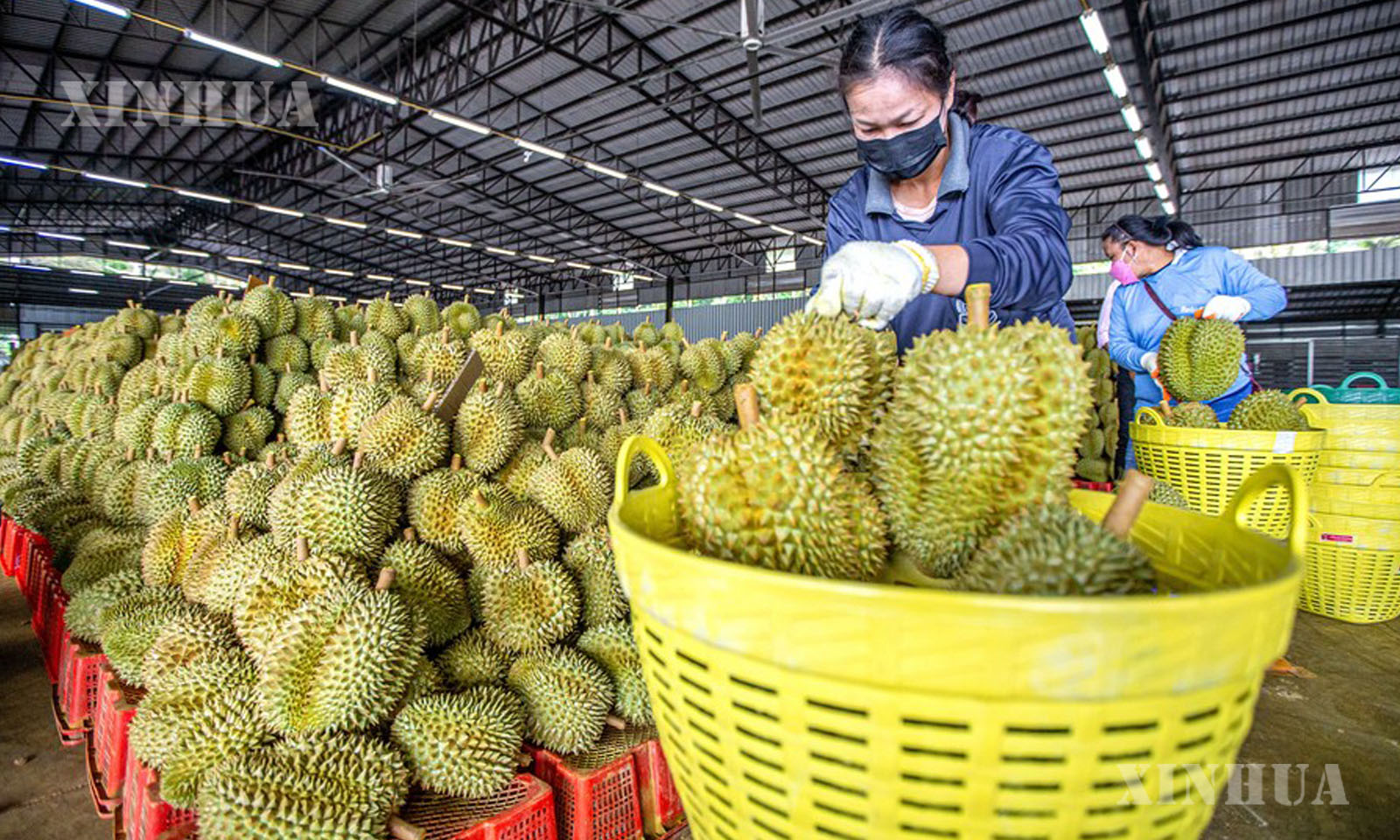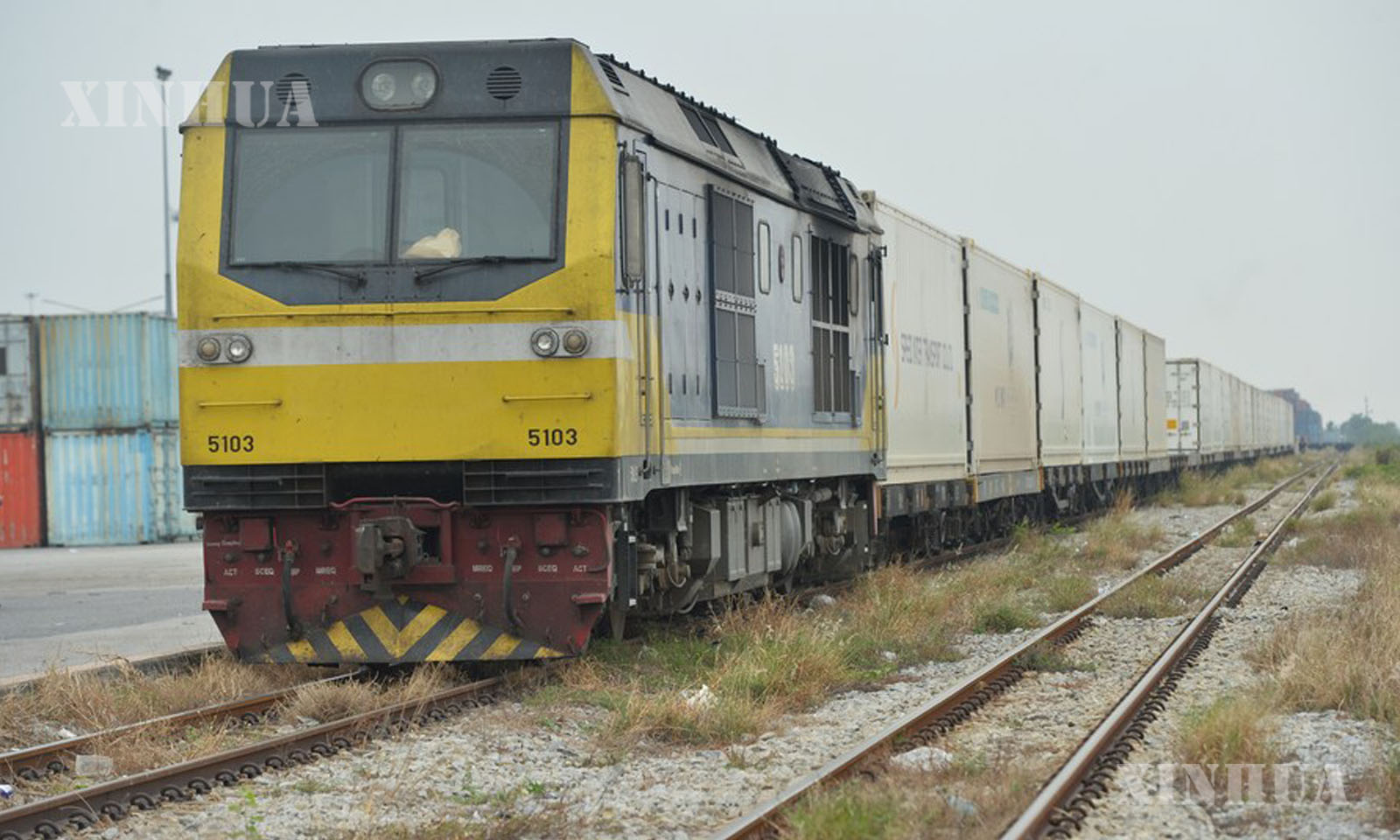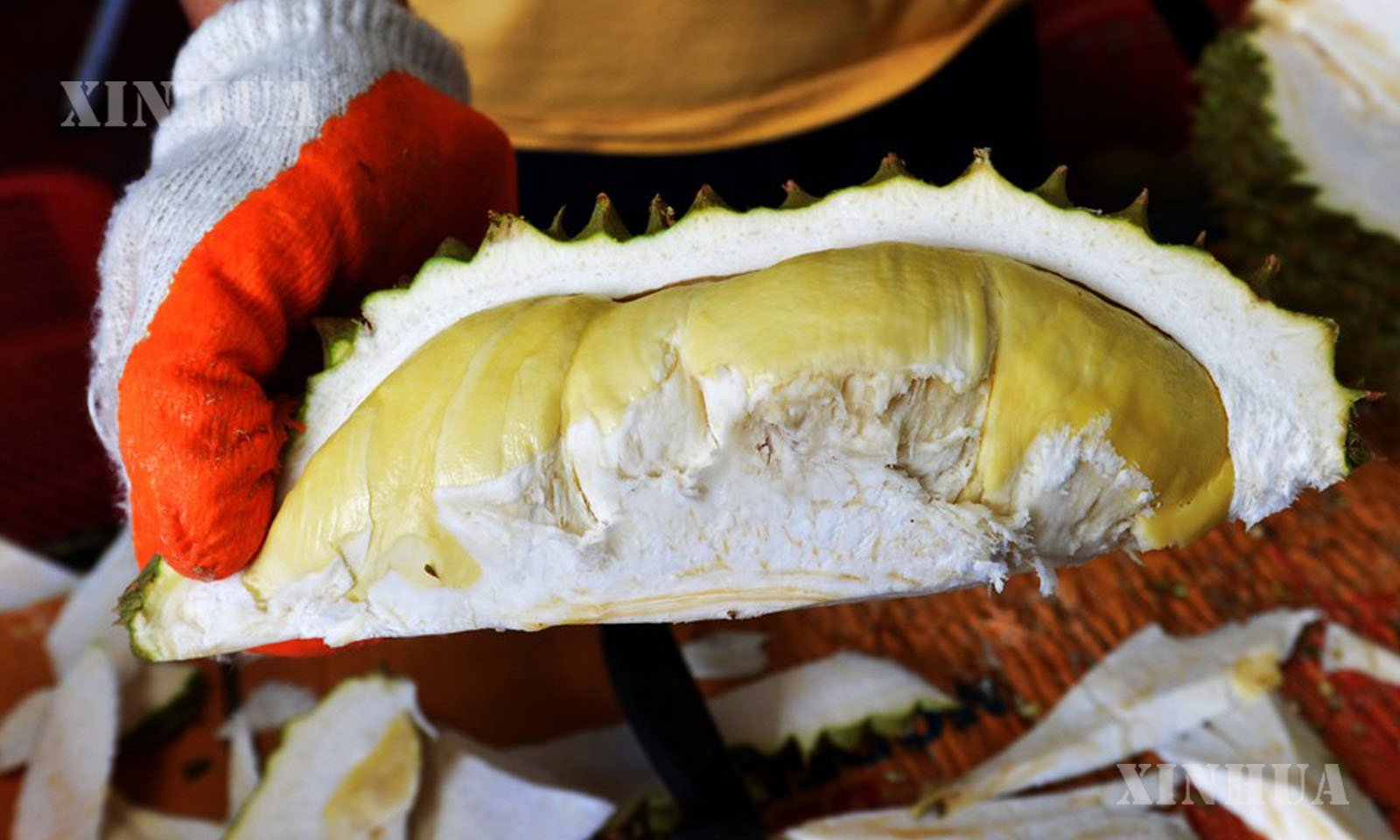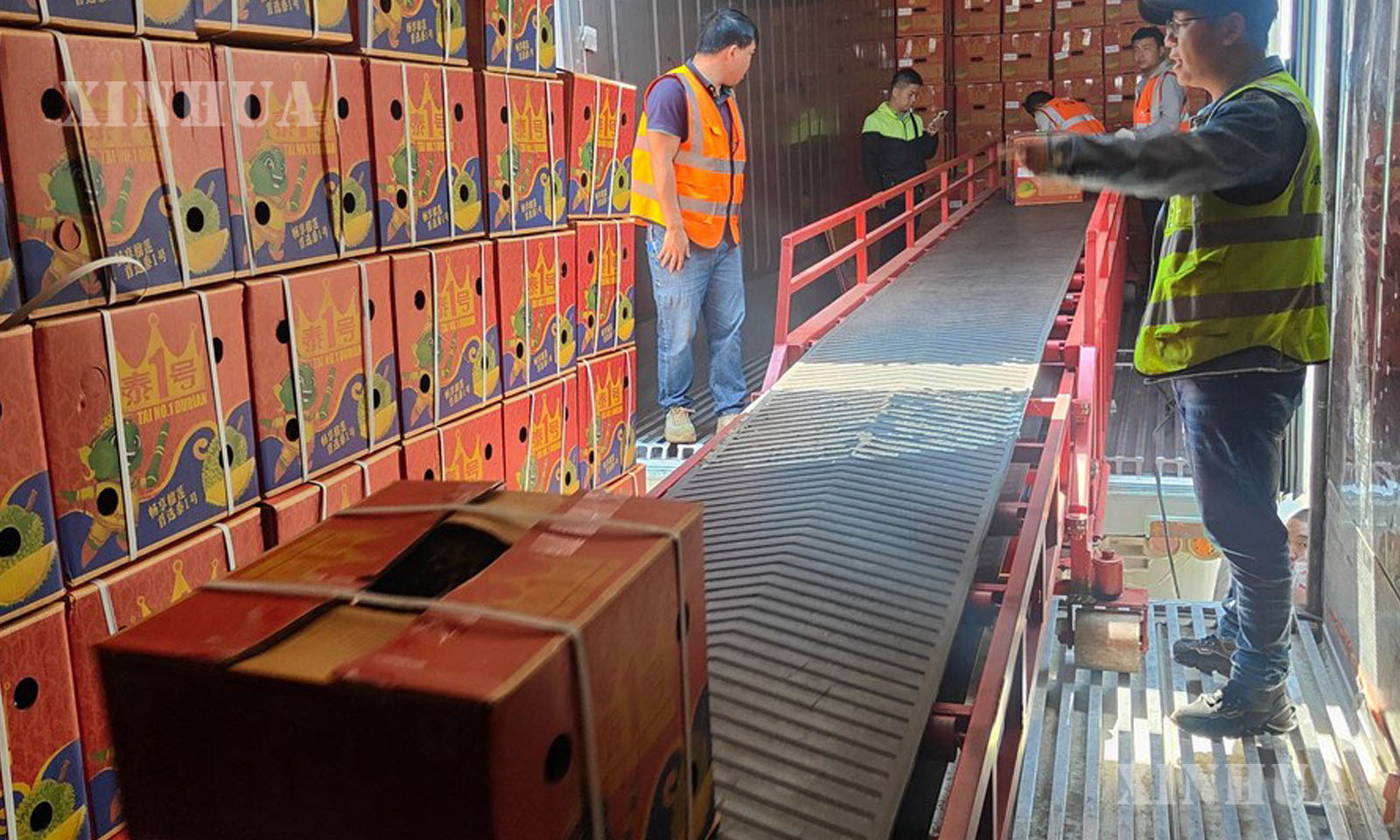China
တရုတ်-လာအို ရထားလမ်းက ထိုင်း ဒူးရင်းသီးများ တရုတ်နိုင်ငံသို့ တင်ပို့မှုကို မြှင့်တင်ပေး

Laem Chabang/ကူမင်း၊ ဧပြီ ၂၀ ရက် (ဆင်ဟွာ)
တရုတ်-လာအို ရထားလမ်းမှ တရုတ်နိုင်ငံဈေးကွက်သို့ လျင်မြန်စွာ ဝင်ရောက်ကြသော ထိုင်းပို့ကုန် ကုန်သည်များ များပြားလာခြင်းနှင့်အတူ ဒူးရင်းသီး၊ မင်းကွတ်သီးများ ပါဝင်သော ကွန်တိန်နာ ၂၃ လုံးတင်ဆောင်လာသည့် “သစ်သီးဝလံတင် ရထား”သည် တရုတ်နိုင်ငံ အနောက်တောင်ပိုင်း ယူနန်ပြည်နယ် ကူမင်းမြို့သို့ ဧပြီ ၁၉ ရက်က ရောက်ရှိခဲ့သည်။

ထိုင်းနိုင်ငံ အရှေ့ပိုင်း Laem Chabangမှ သရက်သီးနှင့်မင်းကွတ်သီးများ တင်ဆောင်ထားသော “သစ်သီးဝလံ ရထား”ထွက်ခွာသွားသည်ကို ၂၀၂၃ ဧပြီ ၁၆ ရက်က တွေ့ရစဉ်(ဆင်ဟွာ)

ထိုင်းနိုင်ငံ ဘန်ကောက်မြို့တွင် အလုပ်သမားတစ်ဦးက ဒူးရင်းသီးပြသနေသည်ကို ၂၀၂၂ ခုနှစ် ဇွန် ၁ ရက်က တွေ့ရစဉ်(ဆင်ဟွာ)

တရုတ်နိုင်ငံ အနောက်တောင်ပိုင်း ယူနန်ပြည်နယ် မြို့တော် ကူမင်းတွင် ထိုင်းနိုင်ငံမှပို့ဆောင်လာသော သစ်သီဝလံများအား အောက်သို့ချနေသည်ကို ၂၀၂၃ ခုနှစ် ဧပြီ ၁၉ ရက်က တွေ့ရစဉ်(ဆင်ဟွာ)
အဆိုပါရထားသည် ထိုင်းနိုင်ငံ၏ အဓိက ဆိပ်ကမ်းဖြစ်သော Laem Chabangမှ ထွက်ခွါပြီး တရုတ်-လာအို ရထားလမ်းကို ဖြတ်သန်းလာခြင်း ဖြစ်သည်။
ထိုင်းနိုင်ငံ လယ်ယာစိုက်ပျိုးရေးနှင့်ပူးပေါင်းဆောင်ရွက်ရေးဝန်ကြီးဌာန အပင်ပို့ကုန်သွင်းကုန်ဆိုင်ရာ ပညာရှင်အဖြစ်လုပ်ဆောင်ခဲ့ဖူးသူ အသက် ၆၇ နှစ်အရွယ် Orathai Euatrakoolက ထိုင်းနိုင်ငံ ဒူးရင်းသီးပို့ကုန် တိုးတက်လာမှုကို နှစ်ပေါင်းများစွာ စောင့်ကြည့်လေ့လာခဲ့သည်။
“အရင်က ဒူးရင်းသီး အများအပြားကို ကုန်းလမ်း ဒါမှမဟုတ် ရေကြောင်းလမ်းနဲ့ တရုတ်နိုင်ငံကို ပို့ဆောင်ကြတယ်။ ဒါပေမဲ့ ရာသီဥတု ဆိုးဝါးမှုကြောင့် ဒီလမ်းတွေက ခန့်မှန်းရခက်ပါတယ်။ တစ်ခါတလေ ရက် ၂၀ လောက် ကြာမှ ရောက်တတ်ပါတယ်”ဟု Orathaiက ထွက်ခွာသွားသည့် ရထားကို ကြည့်ရင်း ပြောသည်။
လက်ရှိတွင် ကုန်ပစ္စည်းများကို ထိုင်းနိုင်ငံက တရုတ်-လာအို ရထားလမ်းမှတစ်ဆင့် သယ်ယူပို့ဆောင်ခဲ့ပြီးနောက် ၃ ရက်အကြာ၌ ကူမင်းမြို့သို့ ရောက်ရှိနိုင်သည်။ ထိုအခါ ဒူးရင်းသီး အရင့်များကို ပို၍ တင်ပို့နိုင်မည် ဖြစ်သည်။ ဒူးရင်းသီးပို၍ရင့်လေ အရသာပို၍ကောင်းမွန်လေ ဖြစ်သည်။
“တရုတ်-လာအို ရထားလမ်း အအေးကွင်းဆက်ဖြင့် သယ်ယူပို့ဆောင်တဲ့အခါ ပိုပြီးများပြားတဲ့ တရုတ်စားသုံးသူတွေက ထိုင်းနိုင်ငံသားတွေလိုပဲ ပိုပြီးလတ်ဆတ်၊အရသာရှိတဲ့ ထိုင်းဒူးရင်းသီးတွေကို စားသုံးနိုင်ကြလိမ့်မယ်လို့ မျှော်လင့်ပါတယ်”ဟု Orathaiက ဆိုသည်။ (Xinhua)
………………………………..
(English Version)
Thailand’s durian export to China facilitated by China-Laos Railway
LAEM CHABANG/KUNMING, April 20 (Xinhua) — A “fruit train” carrying 23 containers of durian and mangosteen arrived in Kunming, capital of southwest China’s Yunnan province, on Wednesday, as Thai exporters increasingly turn to the China-Laos Railway for quick access to the Chinese market.
The train left Laem Chabang, Thailand’s major port, and was transshipped by the China-Laos Railway.
Orathai Euatrakool, a 67-year-old former plant import and export expert for Thailand’s Ministry of Agriculture and Cooperatives, has observed the growth of durian exports in Thailand over the years.
“Previously, large numbers of durians were delivered to China mostly by road and sea, but these routes were highly unpredictable due to factors such as bad weather, sometimes taking more than 20 days to arrive,” Orathai told Xinhua as she saw off the departure of the train.
Currently, goods can reach Kunming in three days after being hauled by the China-Laos Railway from Thailand, where more mature durians will be exported. The more mature the durian, the better the taste.
“Through the cold chain transportation on the China-Laos Railway, we hope that more Chinese consumers can enjoy the fresh and delicious Thai durians just like Thai people,” said Orathai.
1. A worker arranges durians at a durian processing factory in Chanthaburi province, Thailand, May 5, 2022. (Xinhua/Wang Teng)
2. A “fruit train” carrying mangoes and mangosteens is seen in Laem Chabang, eastern Thailand, April 16, 2023. (Xinhua/Rachen Sageamsak)
3. A worker shows the pulp of a durian in Bangkok, Thailand, on June 1, 2022. (Xinhua/Rachen Sageamsak)
4. Workers unload fruits transported from Thailand on the China-Laos Railway in Kunming, capital of southwest China’s Yunnan province, April 19, 2023. (Xinhua/Qin Wenlu)






